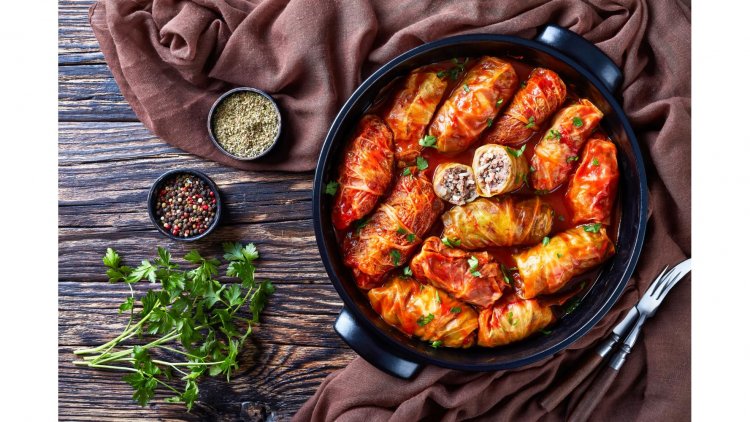Sarmale: A Heartwarming Journey Into Romania’s Soulful Cabbage Rolls
Sarmale, the beloved Romanian dish, is a true culinary masterpiece that brings together a rich blend of tradition, flavor, and nostalgia. The name itself evokes warmth and the comforting embrace of home, as these delightful cabbage rolls stuffed with pork, rice, and spices simmer away to perfection. Sarmale isn’t just a meal; it’s a celebration of Romanian culture and hospitality. Whether enjoyed during festive occasions or as a comforting family dinner, sarmale holds a special place in every Romanian’s heart. The origins of sarmale trace back centuries, likely influenced by various European and Ottoman cultures. Today, it remains a staple in Romanian cuisine, where each region has its own twist on the dish. Some may use different types of meat, while others may add herbs, dried mushrooms, or smoked bacon to the filling. However, the classic version remains tried and true, with tender pork and fragrant rice wrapped in soft, pickled cabbage leaves and slowly cooked to tender perfection

What You’ll Need: Ingredients for Romanian Sarmale
Creating this dish from scratch may take some time, but the outcome is absolutely worth it. For this recipe, we will stick with the traditional ingredients that give sarmale its rich and comforting flavor.
For the Filling:
- 1 kg (2.2 lbs) ground pork (or a mix of pork and beef for a leaner option)
- 200g (1 cup) rice (washed and drained)
- 1 medium onion, finely chopped
- 2 cloves garlic, minced
- 2 tablespoons vegetable oil
- 1 teaspoon paprika
- 1/2 teaspoon thyme (optional)
- Salt and black pepper, to taste
- 100g (1/2 cup) smoked bacon, chopped (optional, but highly recommended for an added depth of flavor)
- 1/2 teaspoon dried dill (optional)
For the Cabbage:
- 1 large head of sour (pickled) cabbage (or fresh cabbage if unavailable, but you’ll need to blanch it to soften the leaves)
For the Stew:
- 1-2 tablespoons vegetable oil
- 500ml (2 cups) tomato puree or passata
- 500ml (2 cups) water or chicken broth (you may need more for extra liquid while cooking)
- 2 bay leaves
- 1 teaspoon peppercorns
- Salt, to taste
- 1 teaspoon sugar (optional, to balance the acidity of the tomatoes)
- 100ml (1/2 cup) white wine (optional)
For Garnish:
- Fresh dill, chopped (optional)
- Sour cream (for serving)
Preparing the Cabbage: The Secret to Perfect Sarmale
Before you can start making the filling, you need to prepare the cabbage leaves. If you have access to pickled (sour) cabbage, this is ideal as it gives the rolls a distinctive flavor. Start by carefully removing the outer leaves. If the leaves are too large, you can cut them in half, making them more manageable for rolling. If you can’t find sour cabbage, use fresh cabbage, but make sure to blanch it in hot water to soften the leaves, which will make them easier to roll.
Tip: To separate the cabbage leaves easily, cut out the tough core with a sharp knife, then submerge the cabbage head in hot water for a few minutes. The leaves will become soft and pliable.
Preparing the Filling: The Heart of Sarmale
In a large pan, heat the vegetable oil and sauté the finely chopped onions until golden. Add the minced garlic and cook for another minute until fragrant. Remove from heat and let the mixture cool slightly.
Next, in a large bowl, combine the ground pork (and beef if using), rice, the sautéed onion and garlic, paprika, thyme, and dill. Add in the chopped smoked bacon, and season with salt and pepper to taste. Mix everything together thoroughly, ensuring that the rice is evenly distributed throughout the meat.
Tip: The rice absorbs moisture while cooking, helping to keep the sarmale tender and juicy. Don’t worry if the filling seems a bit loose—it will firm up once wrapped and cooked.
Rolling the Sarmale: The Art of Wrapping
To roll the sarmale, take a cabbage leaf and place a small amount of filling near the base of the leaf. Fold in the sides and roll tightly, ensuring the filling is secure inside the cabbage leaf. Repeat this process until all the filling is used up, making sure to roll each sarmale as tightly as possible to prevent them from unwrapping during cooking.
Tip: If the cabbage leaves are too small, you can use two leaves to wrap one sarmale. Overlap them and then proceed with the same wrapping technique.
Cooking the Sarmale: Slow and Steady Wins the Race
Once your sarmale are all rolled, it’s time to cook them. In a large pot, heat the vegetable oil and layer the bottom of the pot with a few cabbage leaves to prevent sticking. Then, begin placing the sarmale in the pot in a tight spiral or stack, layering them one on top of the other.
Add the tomato puree or passata, water (or broth), bay leaves, peppercorns, and a pinch of salt. If using wine, pour it in at this stage. Cover the pot with a lid, bring to a simmer, and let the sarmale cook for at least 2-3 hours. The longer they cook, the more tender and flavorful they will become.
Tip: If necessary, add more water or broth during cooking to ensure the sarmale stay covered. Check on them occasionally to make sure they don’t burn.
Serving Your Sarmale: A Feast for the Senses
Once cooked to perfection, serve your sarmale hot with a dollop of sour cream and a sprinkle of fresh dill. These cabbage rolls are often enjoyed with a side of polenta, crusty bread, or pickles to complement the rich flavors. A glass of chilled white wine or a shot of plum brandy (ţuică) is the perfect accompaniment to this hearty meal.
A Taste of Tradition
Sarmale is more than just a dish; it’s a tradition that brings families together. Whether it’s a holiday feast or a simple Sunday dinner, this comforting meal will transport you to the heart of Romania with every bite. The tender pork, the flavorful rice, and the tangy cabbage are a match made in heaven, and the long cooking time only deepens the complexity of flavors.
Even though the preparation can be time-consuming, the end result is a dish that will be loved by everyone around the table. Sarmale is perfect for freezing, so don’t hesitate to make a large batch to enjoy over several days or to share with friends and family. It’s a true symbol of Romanian hospitality and a dish that will warm your heart and soul.
Disclaimer: The recipes shared on this blog are intended for informational and entertainment purposes only. We do our best to ensure accuracy, but ingredient and preparation variations can alter results. Please use caution and consult a medical professional if you have dietary restrictions or health concerns. The blog and its authors are not liable for any adverse effects or consequences resulting from the use of the recipes provided. Always prioritize your health and safety when cooking.
What's Your Reaction?





















